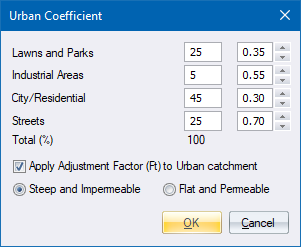
Home > Urban Coefficient Dialog

The runoff coefficient in the Rational Method is an integrated value representing the most significant factors influencing the rainfall-runoff relationship. It represents the part of the storm rainfall contributing to the peak flood runoff at the outlet of the catchment.
The Urban Coefficient Editor allows you to calculate the urban runoff coefficient based on the land usage and characteristics.
The program uses these percentage values plus the following factors to determine the final urban area factor.
|
Usage
|
Description |
Coefficient |
|
Lawns and Parks |
Sandy, flat (< 2%) |
0.05 - 0.10 |
|
|
Sandy, steep (> 7%) |
0.15 - 0.20 |
|
|
Heavy soil, flat (< 2%) |
0.13 - 0.17 |
|
|
Heavy soil, steep (> 7%) |
0.25 - 0.35 |
|
Industrial Areas |
Light |
0.50 - 0.80 |
|
|
Heavy |
0.60 - 0.90 |
|
City and Residential |
Houses |
0.30 - 0.50 |
|
|
Flats |
0.50 - 0.70 |
|
|
City Centre |
0.70 - 0.95 |
|
|
Suburban |
0.70 - 0.70 |
|
Streets |
|
0.70 - 0.95 |
Because of the fairly large percentages of impermeable surface area in urban areas, it is normally not necessary to adjust the urban coefficient according to the return period. Adjustment is however possible according to the same factors as for the rural coefficient. You can specify whether the adjustment factor must be applied, and select either steep and impermeable or flat and permeable. The following factors will be applied during the analysis if this checkbox is selected.
|
Return Period (Years)
|
2 |
5 |
10 |
20 |
50 |
100 |
|
Factor for steep and impermeable |
0.75 |
0.80 |
0.85 |
0.90 |
0.95 |
1.00 |
|
Factor for flat and permeable |
0.50 |
0.55 |
0.60 |
0.67 |
0.83 |
1.00 |
See Also Rational Runoff Data